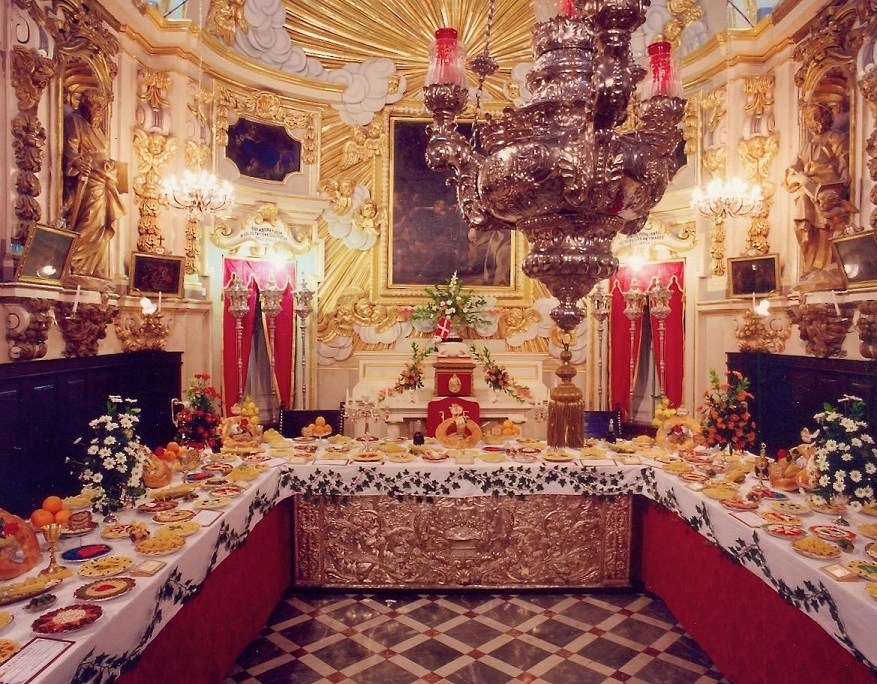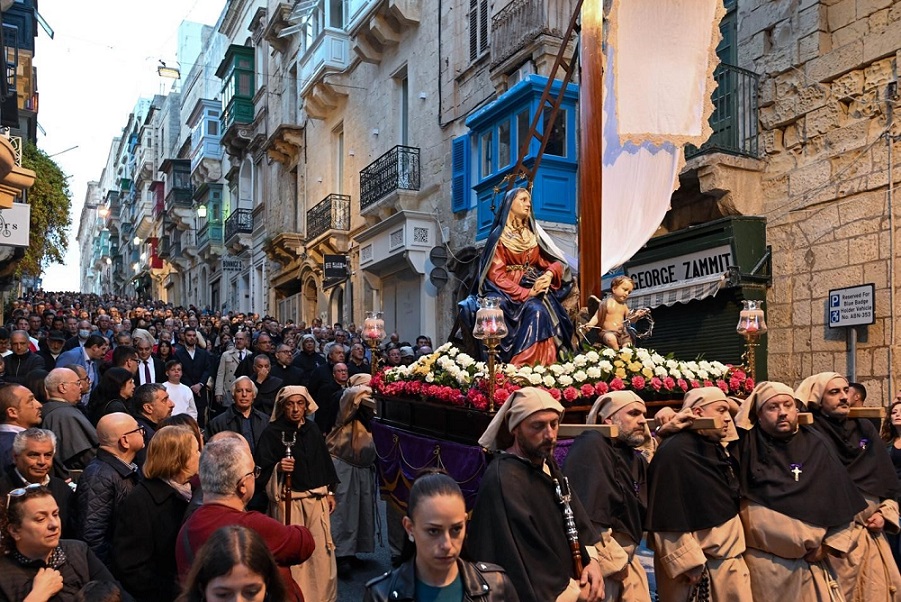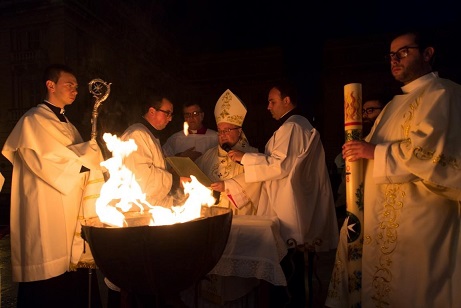Malta is surely one of the best places to visit during the Easter celebrations of Christ’s passion, death, and resurrection.
It is a place where you can be a participant and not just a spectator. Every parish organizes events according to local customs: processions, tableau, Passion plays and exhibitions. Devotions to the Passion of Christ and Easter in general are centuries old. Evidence of this is a fresco that once was in the Monastery of Abbatija tad-Dejr in Rabat, which represents the Annunciation and the Crucifixion, and now, is preserved at the National Museum of Fine Arts (Muża) in Valletta.
The beginning of Lent, Ash Wednesday, follows Mardi Gras. In the Maltese Islands, Lenten sermons are held in all parishes in Malta and Gozo over several days. Statues depicting scenes from the Passion are venerated in several churches. These statues are intertwined in Malta’s artistic, religious, and cultural heritage. The traditional Via Sagra or Way of the Cross is another very popular devotion during Lent, with the faithful meditating at the fourteen Stations of the Cross. During this period, youth clubs or drama groups prepare themselves for the town’s Passion Play.
In the Maltese Islands, the Friday preceding Good Friday is dedicated to Our Lady of Sorrows. In most of the Christian world Holy Week starts on Palm Sunday, however, for the Maltese, it begins on Friday of the Mater Dolorosa. For centuries, this feast has always had a special place in the hearts of the Maltese, who gaze into the Madonna’s eyes and pray to their Suffering Mother. All parishes organize processions in her honor. Traditionally, some of the penitents walk barefoot or drag heavy chains tied to their feet. Women used to walk on their knees, in fulfillment of vows for graces granted. The most popular Our Lady of Sorrows procession is that of the Franciscan Church of Ta’ Ġieżu in Valletta, which was the first to hold this procession in the Islands. This procession is led by the Archbishop of Malta. This Church also houses a miraculous crucifix, known as Il-Kurċifiss Mirakuluż Ta’ Ġieżu. The Crucifix’s realism is so strong that when praying before it, the faithful feel mystically transported to Calvary.

On Palm Sunday, some villages organize enactments of the triumphal entrance of Christ in Jerusalem. During this weekend or the one before, local theaters produce the Passion Drama. One of the oldest traditional Passion plays is held in the crypt of the Basilica of Saint Dominic in Valletta. During the days following Palm Sunday, the Islands are dotted with displays and art exhibitions, in halls, houses and church premises. The representation of the Last Supper table is displayed in most parishes, originating from a three century-old one held yearly by the Dominicans at the Oratory of the Holy Sacrament, in Valletta. The Tableau of the Last Supper is exhibited to reflect Maltese traditions and symbols. The food is donated to the poor and needy of the parish. Other forms of Last Supper displays include those following the biblical decorative style. On Wednesday, the Archdiocese of Malta organizes the National Via Crucis.
The rites of the Holy Week in Malta are quite intricate.
Maundy Thursday, Good Friday, and Easter Sunday are at the heart of colorful but devout manifestation. It is a very strong custom to decorate ground floor windows with miniature statues and draperies creating a shrine of the Crucifixion. Also, lighted crosses are displayed on balconies. Streets are adorned with flags, illuminations and other artifacts. Holy Thursday opens with the Mass of Chrism at Saint John the Baptist’s Co-Cathedral, during which fragrant oil is blessed, to be used in the sacraments of baptism, confirmation, and ordinance. It is also the oil of the Catechumens and the oil of the Infermi.
Artistic, flowered Sepulchers are prepared for Maundy Thursday’s rites. In all churches, the traditional washing of the feet is practiced. The interiors of the churches are covered with black damasks. In the evening, the In Cena Domini, which is the Mass in memory of the Last Supper and the foundation of the Eucharistic sacrament, is celebrated. Parish priests, including the archbishop, washes the feet of twelve men and women representing the Apostles. This is the origin of the traditional “Bread of the Apostles”, a ring-shaped bread topped with seeds and nuts. This customary bread is still sold in bakeries and local confectioneries during this period, and beyond.
After the Cena Domini the Holy Eucharists, to be used in the Good Friday celebration, are brought in procession to the “Sepulchre”, a tabernacle to be worshiped by the faithful in their Visits to Seven Altars of Repose, preferably in seven different churches. The Sepulchres got their name from the tomb of Christ since our ancestors used to put a money box in front of these altars to collect donations for the Holy Sepulchre. On Thursday night (and Good Friday morning) thousands turn out for the Seven Visits. This tradition originated from Philip Neri’s visits to the seven Basilicas in Rome. It is interesting to know that all sepulchers and altars are decorated by white flowers and a whitish seed-plant called gulbiena, which grows in the dark, to emphasize Christ’s rising from darkness.

During Good Friday, the streets of Malta become a massive stage. In the late afternoon, several parishes commemorate the Passion of the Christ through spectacular processions representing the Passion. Effigies of Jesus Christ under the Cross pass from the narrow roads of the Maltese villages, followed by various statues, including that of the Mater Dolorosa. The number of participants, including children, and the realism are quite impressive. In Żebbuġ’s (Malta) procession more than eight hundred persons partake. In the medieval era, after the arrival of the first religious orders on the island, rituals and devotions honoring the Passion of Christ became more prevalent. The Franciscans, who have always been linked to the remembrance of the Passion of Christ, founded the first archconfraternity in Malta, in Rabat, dedicated to Saint Joseph. The exact date of the brotherhood’s foundation is unknown, although the years 1245 and 1345 are mentioned in some documents. Members of this Archconfraternity were the first in Malta to commemorate the Passion amongst themselves. In time, the archconfraternity began to commission some statues portraying episodes from the Passion. From 1591, it became a yearly event, every Good Friday. Afterwards, fraternities of other parishes organized Passion processions in their own villages and cities. The arrival of the Order of Saint John further increased the devotion to the Passion, also placing relics, first in the Church of Saint Lawrence in Vittoriosa and later, in their Conventual Church of Saint John. These included a piece of the Cross of Christ and a thorn from the crown of our Lord.
Holy Saturday is another day of sobriety, at least until the evening. For Easter Vigil celebrations, starting around eight, the faithful gather in front of the church to attend a special function celebrating the resurrection of Christ. At first the church in the dark, but when the Gloria is sung, the church is illuminated, starting with candles held by the faithful lit from the Paschal cero. A fire is ignited outside the church, from which the cero is lit. The Paschal cero is the symbol of Christ, the true light that illuminates every man. Its ignition represents the resurrection of Christ, the new life that every faithful receives from Christ, who, by tearing them away from the darkness, brings them into the kingdom of light. Bells toll in celebration, and the faithful accompany the choir in the Gloria.
Easter day in Malta is marked by the incessant pealing of church bells, and festive, fast-paced processions, with youth running through the streets bearing statues of the Risen Christ (l-Irxoxt). This is the time of joy commemorating Christ’s victory over Death. The Risen Christ is accompanied by the local band, which plays festive marches. People go on their balconies to shower confetti and ticker tape on the procession. Children follow the procession carrying the figollaor the Easter egg. The figolla is a typical Maltese traditional dessert made with almonds and covered with powdered sugar; this dessert can have the form of a rabbit, a fish, a lamb, or a heart. Traditionally, these figollas are blessed by the parish priest during this celebration.
The Maltese are known for their passion for food, and Lent is no exception. A variety of local dishes are interwoven with Easter traditions. Among these, there are the kusksu, which is bean soup, and the qagħaq tal-Appostli. The kwareżimalis another very popular dessert: it is a small cake made of black honey, milk, spices, and almonds. There are also the karamelli, traditional sweets made from carobs and honey. Particular fish and vegetable-based dishes are consumed more, particularly on Ash Wednesday and Lenten Fridays. Bread with kunserva (tomato paste), olives, and tuna is also very popular. Pastry filled with various waddings (spinach, peas, anchovies, cheese etc), known as qassatat and pastizzi (cheese-cakes). On Easter, the whole family gathers for lunch, where lamb dishes are served, and figollais served as dessert.
In this article, I have just floated through the plentiful spiritual moments, religious celebrations, and traditions of the Maltese Easter. The real strength of this Holy season is people’s participation throughout the array of events, both pious and festive. This widespread involvement confers uniqueness to our tiny archipelago. During this period, liturgical moments establish a connection between the members of our community, which also connect us to our ancestors and their prayers recited throughout the centuries.
Written by Jean Pierre Fava, Manager Faith Tourism, Malta Tourism Authority
References
Bonnici B. Dell is-Salib fil-Gżejjer Maltin (The Shadow of the Cross in the Maltese Islands). SKS.
GOT NEWS? click here
Google News, Bing News, Yahoo News, 200+ publications
Bonnici B. Il-Ġimgħa l-Kbira f ’Malta (Good Friday in Malta).SKS.
Bonnici B. Il-Ġimgħa Mqaddsa tal-Ġirien (The Neighbours’ Holy Week). Bronk Publications.
About Malta
The sunny islands of Malta, in the middle of the Mediterranean Sea, are home to a most remarkable concentration of intact built heritage, including the highest density of UNESCO World Heritage Sites in any nation-state anywhere. Valletta, built by the proud Knights of St. John, is one of the UNESCO sites and the European Capital of Culture for 2018. Malta’s patrimony in stone ranges from the oldest free-standing stone architecture in the world, to one of the British Empire’s most formidable defensive systems, and includes a rich mix of domestic, religious and military architecture from the ancient, medieval and early modern periods. With superbly sunny weather, attractive beaches, a thriving nightlife and 8,000 years of intriguing history, there is a great deal to see and do.
For more information on Malta, go to visitmalta.com.
SEEN IN MAIN IMAGE: Lighting of the Paschal Cero by the Archbishop of Malta Charles Jude Scicluna – image courtesy of Malta Tourism Authority – image courtesy of the Archdiocese of Malta. Photo by Ian Noel Pace
MEDIA CONTACTS:
Malta Tourism Authority – North America
Michelle Buttigieg
Tel: (212) 213-0944
Fax: (212) 213-0938
E-mail: michelle-margaret.buttigieg@visitmalta.com
MTA U.S./Canada Editorial Contact:
The Bradford Group
Jillian Sliwinski/Amanda Marconi
Tel: (212) 447-0027 E-mail: visitmalta@bradfordglobalmarketing.com







